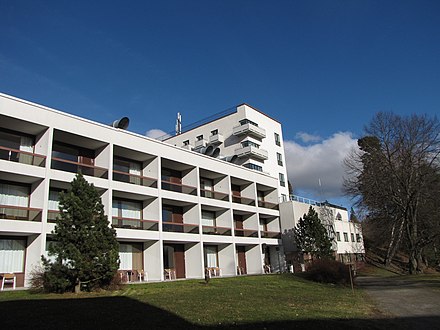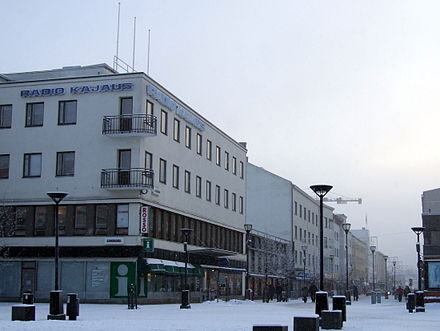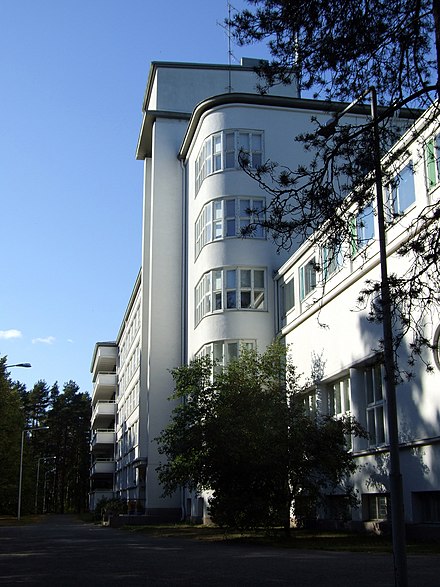Functionalist architecture in Finland
Functionalist architecture in Finland
Finland is one of the best places to see buildings in functionalist style. A great number of these buildings can be seen in the capital Helsinki, but occasionally notable examples of functionalism can be found also in smaller towns.
Understand
.jpg/440px-Helsinki_-_panoramio_(36).jpg)
See also Wikipedia's article about functionalist architecture
Functionalism is a style of modernist architecture that emerged in the interwar period. The style reached its greatest popularity in Eastern Central Europe and Northern Europe. A bit reminiscent of Bauhaus, in functionalism common features include large blank surfaces (usually white, yellow or some other bright colour), straight lines, curved short sides similar to the Streamline Moderne style, simple forms (rectangles and circles) and flat roofs. Decorations such as patterns are rarely used in this style, but the play of light is often carefully used instead. The name functionalism implies that buildings should be designed (if not even optimised) according to their intended use.
Background
Finland had been part of Sweden until 1809 and part of the Russian Empire until 1917. Much of the pre-independence architecture was inspired from those respective countries, and the first decades of the 20th century were dominated by the styles of jugend (art nouveau) and Nordic classicism (the local interpretation of art deco). Even as some of the functionalist buildings (by Aalto especially) were built already in the 1920s, the 1930 Stockholm exhibition was what really made this architectural style fashionable in the Nordic countries. Some functionalist buildings were built in Norway and Sweden (Stockholm especially), but it was in Denmark and Finland that this style had the biggest impact.
In Finland, functionalism arrived at a time of urbanization and industrialization, which had started at the turn of the century. Cities grew rapidly, and public and residential buildings were built – many of them in the style of functionalism; which also became an expression of the country's newly won independence. The style continued to be popular until the 1960s, and especially in bigger cities like Helsinki and Turku there are plenty of functionalist buildings, and the style of architecture can also be encountered in smaller towns. Of course, many buildings from that day have been replaced by newer ones. Famous Finnish functionalist architects of the period include Erkki Huttunen, Pauli E. Blomstedt, Aarne Ervi, Viljo Revell, Eino Pitkänen, Erik Bryggman, Gunnar Wahlroos, Hilding Ekelund and Alvar Aalto; they would also come to create buildings in other modernist styles.
The country has two official languages; Finnish and Swedish. The Finnish language is not Indo-European, and therefore has grammar very different from most European languages. The bilingual experience has been cited as a source of inspiration for Finnish art, architecture and pattern design. Finland is traditionally Protestant. Both churches and other buildings share minimalist features with other Protestant communities.
Finland is also famous for interior design (including furniture, kitchenware and textiles) with brands such as Iittala, Fiskars, and Marimekko. Some famous items of interior design were designed by Alvar Aalto.
See
These buildings are famous examples of functionalist architecture; most are listed by the Board of Antiquities as "Nationally Remarkable Built-up Cultural Environments" (Fi. valtakunnallisesti merkittäviä rakennettuja kulttuuriympäristöjä) and/or by the modern architecture conservation organization Docomomo International as notable examples of modern architecture.
Few of the buildings below are "pure tourist attractions", though some serve as restaurants, hotels, event venues etc. and are freely accessible to the public. Others may be inappropriate to enter, at least without previous appointment with someone connected to the place, and such buildings can just be admired from the outside.
Helsinki and surroundings
Töölö is likely the district with the highest concentration of functionalist buildings not just in Helsinki but in all of the country. In addition to the ones listed below, the district has are several other buildings in functionalist style, for instance a former gas station turned grocery store in the corner of Mechelininkatu and Hietaniemenkatu and multiple apartment buildings. Käpylä does also have several such buildings, elsewhere in the city they are more spread out.
Töölö
-
Olympic Stadium (Olympiastadion), Paavo Nurmen tie 1. The stadium which was built for the 1940 Helsinki Olympics, which were held 12 years later due to the Second World War, is with its 72-m-high tower one of the finest examples of functionalism. It was opened in 1938, and designed by Yrjö Lindegren and Toivo Jäntti. Unlike some modern-day Olympic venues that have been left disused after the event, Helsinki's Olympic Stadium continues to be a prime sports and concert venue and has been renovated several times. It is undergoing further renovation as of Nov 2019, and is scheduled to reopen in August 2020. The next door swimming stadium (uimastadion) built for the same Olympics follows the same style. The stadium also hosts the Finnish Sports Museum (Suomen urheilumuseo). 2019-11-11
-
Rowing stadium (Soutustadion/Roddstadion). Taivallahti Bay on the west coast of Helsinki peninsula was the planned venue for rowing and canoeing events in the same Olympics, though just the latter took place there. The white elegant seating area designed by Hilding Ekelund is closed to the public. 2019-11-11
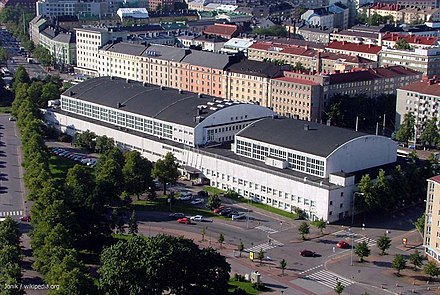
-
Töölö Sports Hall (Töölön Kisahalli/Tölö sporthall), Mannerheimintie 17. Next to the Olympic Stadium is the Töölö Sports Hall, designed by Aarne Hytönen and Risto-Veikko Luukkonen, which was first opened as an exhibition hall in 1935. Some indoor sports events of the Olympics were held here, and since a new exhibition hall in Pasila opened in 1975 it is purely a sports venue, the home of basketball teams Helsinki Seagulls and Torpan Pojat and open to the general public to work out. Or, if your late-night partying has gone a bit too far, you may wake up in the basement where the police operates drunk tanks. 2019-11-16
-
Children's Castle (Lastenlinna/Barnens borg). Elsi Borg, Otto Flodin and Olavi Sortta designed this hospital building which was finished in 1948. As the name reveals, it was a hospital specializing in treating children. In the last years, some part of the building was always under repair, wherefore a new children hospital was opened nearby in 2018. As of 2019 the building stands empty and the City of Helsinki has yet do decide what to do with it. 2019-11-11
-
Olaus Petri church (Olaus Petrin kirkko/Olaus Petri kyrka), Minervankatu 6. The yellow Olaus Petri church by the Swedish architect Ture Ryberg was finished in 1932 and it's the main church of Swedish citizens in Finland. Thanks to the good acoustics, the church is also a concert venue, used by the Sibelius Academy, for example. The church's organ was built in Gothenburg in 1967 and has 26 pipes. 2019-11-11
-
Lallukka Artist's home (Lallukan taiteilijakoti/Lallukka konstnärshem). Opposite Olaus Petri church is Lallukka, a residential building for artists finished in 1933. It's managed by the Juho and Maria Lallukka Art Home Foundation, established after the death of businessman and patron of arts Juho Lallukka. The 56 apartments and studios has housed several famous Finnish painters, sculptors, composers, musicians, film directors and actors. In the same block, on Eteläinen Hesperiankatu, is Restaurant Elite from the same era. One of the grand old fine dining places in the city, it was the place for artists to gather back in the day. 2019-11-11
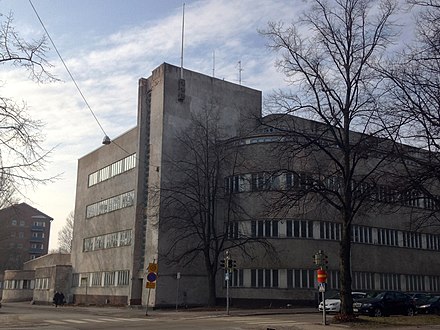
-
Taivallahti barracks (Taivallahden kasarmit/Edesvikens kaserner), 60.1770°, 24.9170°. The buildings designed by Martta Martikaisen were finished just before World War II. Army drivers and the military band Kaartin soittokunta served here until 2012, and the buildings that are in a somewhat rundown shape as of 2019 will eventually be converted to residential buildings and a grocery store operates on the first floor in one of them. 2019-11-11
-
Helsinki Business University (Kauppakorkeakoulu/Finska handelshögskolan). Opened in 1950, and designed by Woldemar Baeckman and Hugo Harmia, this building isn't a purely functionalist one but also incorporates some reliefs in Romantic style. The business university has since merged with the technical and arts universities to form the Aalto University and the campus have moved to Otaniemi in 2019. After a renovation it will be turned into a "Executive Education Center". 2019-11-11
-
Helsinki Suojeluskunta Building (Helsingin suojeluskuntatalo/Helsingfors skyddskårshus), Pohjoinen Hesperiankatu 15. This building was constructed in 1939-41 as the Helsinki headquarters for the Suojeluskunta militia organization, which was banned after the war. It is nowadays an office and commercial building, and the most famous tenant was Restaurant Motti functioning in the building until 1987, and after that on and off. 2019-11-21
Central and southern Helsinki
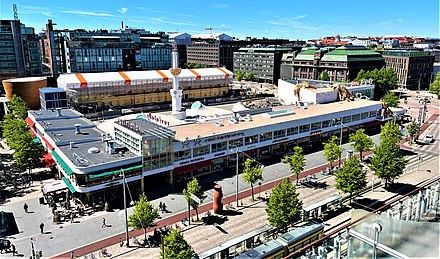
-
Lasipalatsi (Glaspalatset), Mannerheimintie/Simonkatu (Kamppi). Another of Helsinki's most iconic functionalist buildings right next to Mannerheimintie, the "glass palace" by Viljo Revell, Heimo Riihimäki and Niilo Kokko was finished in 1936 and is functionalist both on the inside and outside. It was planned as a temporary office building and shopping mall, to be replaced by a bigger one in the future but that never happened. In the 1980s and 90s the building was in a fairly sorry state but due to opposition by citizens and the Board of Antiquities it wasn't demolished but underwent a major restoration at the turn of the millenium. Today the gorgeous white building with colourful neon signs houses shops, restaurants, the movie theater Bio Rex, and beneath it, the art museum Amos Rex. 2019-11-11
-
Main post office (Postitalo/Pääposti/Huvudposten), Mannerheiminaukio 1 (Central Helsinki). Across Mannerheimintie from Lasipalatsi is Helsinki's former main post office, designed by Jorma Järvi, Erik Lindroos and Kaarlo Borg and finished in 1938. However, nowadays since the late 1990s it's not the main post building, but houses a number of shops, but the building is still protected as a valuable historical building (just like most buildings on this list). 2019-11-11
-
Metsätalo, Unioninkatu 40 (Kaisaniemi). This university building has been described as having both functionalist and classicist elements. It was designed by Jussi Paatela, finished in 1939 and its first users were the State Forest Research Institute (Metsätutkimuslaitos) and Helsinki University's faculty for forest science, and that's where the building's name — "the forest house" — came from. Nowadays the building houses the linguistics and philology faculties. 2019-11-11
.jpg/440px-Punavuori,_Helsinki,_Finland_-_panoramio_(2).jpg)
-
Mikael Agricola church (Mikael Agricolan kirkko/Mikael Agricola kyrka), Tehtaankatu 23 (Punavuori). Designed by Lars Sonck who won an architect contest and finished in 1935, this functionalist building is unusually made of red bricks. Another unusual thing is the spire that can be lowered into the tower, reducing the height of the tower by a third. This feature was used during World War II to avoid it becoming a landmark for bomber planes. 2019-11-12
-
Luther church (Luther-kirkko/Lutherkyrkan), Fredrikinkatu 42 (Kamppi). In this church, just the façade is functionalist. The building itself is from the 19th century, but the façade was remodelled in 1931 after a design by Hilding Ekelund. After functioning as a nightclub for a few decades, the building is once again used as a church by the conservative Lutheran Evangelical Foundation. 2019-11-11
-
Tennis Palace (Tennispalatsi/Tennispalatset), Salomonkatu 15 (Kamppi). Designed by Helge Lundström and finished in 1937, the "tennis palace" did house four tennis courts but has been used for a lot of different purposes. In the 1952 Olympics, it was used for basketball games, then the building housed a car dealership and Anttila department store. Like the nearby Lasipalatsi, in the 1990s the building was in a pretty shabby shape and there were plans to demolish it and replace it with a new bus terminal. Tennispalatsi was nevertheless renovated, and since the turn of the millenium it has housed a large movie theater and the Helsinki Art Museum (HAM). 2019-11-11
-
House of the Book (Kirjan talo/Bokens hus), Kirjatyöntekijänkatu 10 (Kruununhaka), 60.1761°, 24.9558°. The "House of the Book", by Georg Jägerroos and finished in 1935, is the house of Helsinki Bookworker's Union (which in turn is the oldest trade union in the country, established in 1869). The seven-story building houses conference rooms, apartments, a restaurant, a sauna and a banquet hall. 2019-11-11
Inner East
- Sturenkatu 21, Sturenkatu 21 (Vallila), 60.1925°, 24.9532°. First built as a Volvo dealership, the big functionalist building was finished just before World War II. Since 1980, the it's mainly been the post office of the Vallila district, though it has also hosted offices, shops and restaurants. In 2020 the actual post office was closed down but the Post has parcel lockers stationed there. 2019-11-11
- Helsinki Velodrome (Velodromi/Velodromen), Mäkelänkatu 70 (Kumpula). Opened in 1940, and designed by Hilding Ekelund, its design reveals that this is another sports venue built for the Helsinki Olympics that were postponed by World War II. Aside of cycling events, the grassfield in the middle is nowadays used for American football and field hockey games. 2019-11-11
- Olympic village (Olympiakylä/Olympiabyn), 60.2105°, 24.9502°. The buildings by Martti Välikangas and Hilding Ekelund that were built to house the Olympic athletes for the postponed 1940 Olympics were taken into residential use after the war. For the athletes participating in the 1952 Olympics, a new village named Kisakylä (lit. "competition village") was quickly constructed just south of the former, also in functionalist style. 2019-11-11
- Käpylä church (Käpylän kirkko/Kottby kyrka), Metsolantie 14 (Käpylä). A white early functionalist building from 1930, with some elements of classicism, it was designed by Eero Ilmari Sutinen. The 22-pipe organ of the church were designed in 1977 by Bey Heng along the lines of the rest of the church. 2019-11-11
Further out
-
Tilkka, Mannerheimintie 164 (Pikku Huopalahti). Already in 1918 a military hospital was established here, and the current white building by Olavi Sortta with its very iconic set of round balconies was finished in 1936. The central military hospital functioned in the building until late 2005, and nowadays it is a nursing home. 2019-11-11
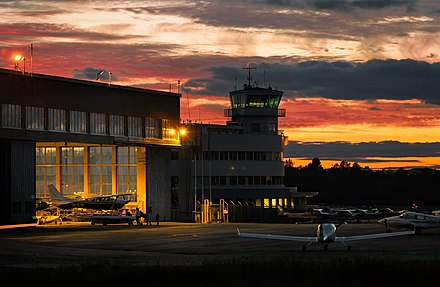
-
Malmi airport (Malmin lentoasema/Malms flygplats). Opened in 1936, the airport didn't serve long as Helsinki's major airport – already in 1952 the current airport opened and since then Malmi did serve as a general aviation field until early 2021 (for the last years as an uncontrolled airfield). The buildings of the airport, especially the terminal building, are good examples of functionalist architecture. Since the turn of the millenium the future of the airport was uncertain, as the City of Helsinki planned to shut down the airport and build apartment buildings in the area. In 2021 the remaining users were evicted. 2019-11-11
-
Kulosaari church (Kulosaaren kirkko/Brändö kyrka), Kulosaarentie 40 (Kulosaari). By Bertel Jung and Armas Lindgren, and finished in 1935 (bell tower already in 1931), this church incorporates some elements that aren't functionalist at all such as the base made of rocks. 2019-11-11
-
Pihlajamäki (Rönnbacka), 60.2346°, 25.0102°. Residential district built in the early 1960s. Even as the buildings themselves aren't strictly functionalist, but represent some of the earliest plattenbau-style buildings in the country, the zoning plan by Olli Kivinen is said to represent the "principles of functionalist city planning in a Finnish environment". 2019-11-11
Elsewhere in Uusimaa
Espoo and Vantaa only started to grow in the 1950s, and apart from some factories they were mostly rural. As such major buildings tend to be from the time after functionalism.
-
Westend. The district was built as a wealthy residential district with the first houses emerging in the 1930s. The district was inspired by similar districts in the UK and USA, and to emphasize this, the English name was chosen. Several architectonical styles are represented here; notable functionalist villas are at Liinasaarentie 5 (Olavi Numminen, 1938), Villa v. Heiroth at Mansikkatie 2 (Matti Finell, 1936), and at Länsilinnake 2 (Aulis Kalma, 1939). 2019-11-11

-
Tapiola (Hagalund). Tapiola, just north of Westend, was designed as a garden city starting in the late 1950s. The designer of the zoning plan was Aarne Ervi, who also designed many of the buildings in different modernist styles. The Tapiola swimming pool and Kino Tapiola movie theater can be regarded as examples of functionalism. 2019-11-12
-
Satomäki, 60.2975°, 25.0618°. One of Vantaa's first apartment building suburbs, and set up in the 1950s, it is planned according to functionalist principles. On the top of the hill (Satomäki means "harvest hill") there are higher apartment towers, and below them lower but longer apartment buildings. Early houses are designed by Tauno Salo and Maija Johanson, the zoning plan by Antero Markelin. 2019-11-11
-
Rajamäki church (Rajamäen kirkko). This church the national alcohol monopoly Alkoholiliike had built for the staff of its Rajamäki factory. It's one of the most notable functionalist churches, designed by Erkki Huttunen and finished in 1938. The church, which also has some classicist features, has several works of art – reliefs, frescoes and paintings. 2019-11-21
Turku and surroundings
One of most famous functionalist architects, Erik Bryggman, lived and worked in Turku, and many of his buildings (both functionalist and other styles) can be found here. Also some of Finland's very earliest functionalist buildings, by Alvar Aalto, are in Turku.
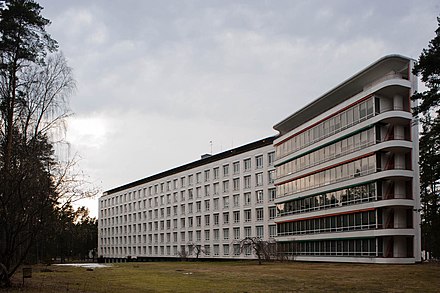
-
Paimio sanatorium (Paimion parantola). A tuberculosis sanatorium designed by Alvar Aalto, and finished in 1933. Over the years different kinds of medical services has been provided in the building, and since 2014 it has been a rehab facility for children and youth but not all of the building is in use. The building is on UNESCO's tentative list for World Heritage Sites. 2019-11-11
-
Läntinen Pitkäkatu 20 (Västerlånggatan 20), 60.4537°, 22.2573°. The white apartment building at Läntinen Pitkäkatu 20 was designed by Alvar Aalto in 1928. Known as "Aalto's standard rental house", he wanted to create an entirely new type of home for the city dweller. He also envisioned a whole new line of furniture for the building's apartments. It's regarded as Finland's first functionalist building, and was supposed to be the first of many more similar buildings. 2019-11-11
-
Turun Sanomat building (Turun Sanomien toimitalo), Kauppiaskatu 5. Six-floor building by Alvar Aalto finished in 1930 for the city's largest newspaper Turun Sanomat, who still retain their customer service in the building. Already from the beginning the building also included apartments, one of which was reserved for the paper's editor-in-chief. The building follows the principles for modern archtecture laid out by Le Corbusier a few years earlier including a pillar system, horizontal lines of windows and a roof terrace. 2019-11-11
-
Martin's Church (Martinkirkko/Martinskyrkan), Huovinkatu 5. Designed by Totti Sora and Gunnar Wahlroos and opened in 1933 for the 450th anniversary of Martin Luther. The simplistic church is a fusion of Nordic Classicism and functionalism. 2019-11-11
-
Vasaramäki (Hammarbacka). This district features some functionalist buildings by Erik Bryggman such as the church community building and residential buildings. 2019-11-11
-
Resurrection Chapel (Ylösnousemiskapelli/Uppståndelsekapellet), Hautausmaantie 21. In the middle of Turku Cemetery, in the south of Vasaramäki, by the same architect and finished in 1941, is the Resurrection Chapel. It is made to blend into the environment, which is notable also on the inside as the big windows or rather glass wall brings the forest into the chapel. The building also features sandstone reliefs and is regarded as one of the finest examples of late functionalism in Europe. 2019-11-11

-
Southwestern Finland Agricultural Cooperative building (Lounais-Suomen Maalaistentalo), corner of Humalistonkatu and Puutarhakatu. Another of Aalto's early functionalist works, finished in 1928 and featuring some classicist elements. The building has been used for many purposes; residential, cultural and commercial — for instance several theaters have functioned in the house over the years. As of 2019 the building houses a hotel, apartments and some restaurants. In the same block, on Yliopistonkatu side, is Hospits Betel and in the middle of it, Betel Church. The former is a 1929 hotel designed by Erik Bryggman that he first intended to design in Italian classicist style, but finally became a mostly functionalist building, now housing a Scandic hotel. The church was finished in 1906, but in 1927 a functionalist belltower and stairway was added, also planned by Bryggman. In the same block is also another work by Bryggman, the classicist Atrium residential house. 2019-11-11
-
Turku concert hall (Turun konserttitalo/Åbo konserthus), Aninkaistenkatu 9. Finished in 1952 after a design by Risto-Veikko Luukkonen, and since then the home of Turku Philharmonic Orchestra, founded in 1790 and one of the oldest still active orchestras in the world. The hall is famed for its good acoustics, and the inside was planned by acoustics specialist Paavo Arni. The hall has also been used for rock and pop concerts, conferences and exhibitions. 2019-11-11
-
The White house (Valkoinen talo/Vita huset). Office building by Gunnar Wahlroos, finished in 1937. The first tenant was the shipbuilder Crichton-Vulcan, that in the following year merged with Wärtsilä. Until the 1970s the Turku shipyards were nearby at the mouth of Aura river, then it moved to larger facilities in Perno outside the city and eventually the offices also followed. As of 2019, the building houses the headquarters of the Elomatic engineering company. 2019-11-11

-
Turku bus station (Turun linja-autoasema/Åbo busstation). The bus station from 1938 was designed by Harald Smedberg and Totti Sora and is still in use. Next to it there are two other functionalist buildings that used to be Esso and Shell gas stations, but nowadays house a hotel (Hotelli Helmi) and a Hesburger restaurant (this is Turku, after all!). 2019-11-11
-
Turku Central Railway Station (Turun päärautatieasema/Åbo centralstation), Ratapihankatu 37. The current railway station for Turku was finished in 1940 and designed by Martti Välikangas and Väinö Vähäkallio. From the street side the station looks a bit like a triumphal arch with a big glass window in the middle, surrounding the entrance. 2019-11-21
Southeastern Finland
-
Kotka city hall (Kotkan kaupungintalo), Kustaankatu 2 (Kotka), 60.4675°, 26.9471°. A six-floor massive building overlooking the market square (Kauppatori), the building was designed by Erkki Huttunen and finished in 1934. 2019-11-11
-
{{listing | type=see | name=Metsola school | alt=Metsolan koulu | url=https://peda.net/kotka/perusopetus/metsolan-koulu (dead link: December 2020) | email= | address=Allintie 9 | lat= | long= | directions=Kotka | phone= | tollfree= | hours= | price= | wikipedia= | wikidata=Q11882277 | lastedit=2019-11-11 | image=Metsolan koulu.jpg | content=An elementary school in the Metsola suburb, designed by G. A. Wigström and finished in 1939. During the war the building served as a hospital. Nowadays it's the place of study for 170 pupils in grades 1-5. }}
-
Pioneeripuisto. The current Pioneeripuisto (lit. "military engineer's park") in the village of Koria, nowadays part of Kouvola, was until 1994 the site of the Koria barracks. The barracks were already established before WWI, though some of the buildings are built later in functionalist style, including the officer's building (1927), the engineering school (1936, designed by Olavi Sorta), the cafeteria (1938, designed by Elsi Borg) and the canteen (1959). 2019-11-11
-
Kino Aula, Valtakatu 39 (Lappeenranta), 61.0587°, 28.1901°. A former movie theater, finished in 1938. In the 1960s when the television made business unprofitable, the house was used as a roller skating hall and a disco, but eventually it was taken into use as a movie theater again. Kino-Aula and the next door movie theater Nuijamies again struggled with profitability in the 2010s, and in 2016 Finnkino bought both of them, closed them down almost immediately and emptied them of chairs and equipment. As of 2019 it's unclear if they will be torn down or converted for some other use. 2019-11-11
-
Lapinjärvi Educational Center, Latokartanontie 97 (Lapinjärvi). On the grounds of Sjökulla Manor, four functionalist buildings were finished in 1939 as an alcoholics' rehab center, but as World War II broke out, the buildings were instead used by the military as a hospital and barracks. Afterwards it was indeed used for its intended purpose, and in the 1990s as a reception center for refugees. Since 1998 the buildings have been part of Siviilipalveluskeskus, the educational center for those performing civilian service (alternative to military service for conscientious objectors). 2019-11-11
Vyborg and Karelia
In the heyday of functionalism, the 1930s, Vyborg was a Finnish city and one of the most important. As such, a couple of functionalist buildings were built in the eastern part of the city, mostly in the district known as Pantsarlahti. Apart from the Aalto library, they're not in such a great shape nowadays.
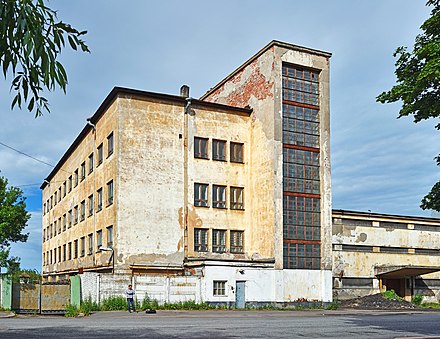
-
Vyborg library, Prospekt Suvorova 4. Vyborg's library was designed by Alvar Aalto and finished in 1935 as one of his most famous works. During the Soviet times it was remodelled and eventually left to decay due to a lack of funding. Finally in the 2000s, the library underwent a massive restoration project, finished in 2013. It's now once again one of the top attractions of the city. 2019-11-11
-
Hankkija office, Ulitsa Danilova 7, 60.7042°, 28.7404°. In 1932, this building designed by Erkki Huttunen was finished as the Viipuri office and warehouse for the Hankkija company selling farming equipment and machinery. Nowadays the building together with the surrounding ones are used by the Russian military. 2019-11-11
-
Seventh-day adventist church, Sadovaya Ulitsa/Kamennyi pereulok, 60.7048°, 28.7491°. Built in 1935 after a design by V.Rautiainen as a prayer room for the adventist church, and still serves the same purpose. 2019-11-11
-
SOK mill, Morskaya Naberezhnaya 3, 60.7063°, 28.7397°. Designed in 1932 by Erkki Huttunen, as a mill and granary for the SOK (Suomen Osuuskauppojen Keskuskunta, lit. Central Finnish Cooperative Society). This building was built as — and continues to be used as — a bread factory, the Vyborg Bread Combine. 2019-11-11
-
OTK central warehouse, Morskaya Naberezhnaya, 60.7070°, 28.7376°. The Viipuri warehouse of wholeseller OTK (Osuustukkukauppa, lit. Cooperative Wholeseller), designed by Georg Jägerroos in 1936. 2019-11-11
-
Karjala insurance company building, Leningradskoye shosse 7. Constructed during World War II after a design by Olli Pöyry and finished in 1943, this was the highest residential building in Finland at the time of completion. It housed the Karjala insurance company and was known as Vyborg's skyscraper. After the war it has been a residential building, with shops on the ground floor. 2019-11-11
-
Pharmacist Jääskeläinen's villa (Apteekkari Jääskeläisen huvila), 61.781764°, 30.782944°. Designed by Pauli Blomstedt as a holiday home for the Helsinki pharmacist Tauno Jääskeläinen and finished in 1937. Nowadays an artist home for Russian artists. 2019-11-21
-
In the cities of Sortavala, Priozersk (Käkisalmi), and Svetogorsk (Enso) you can also find some functionalist buildings from the Finnish time.
Tampere

-
Tampere railway station (Tampereen rautatieasema), Rautatienkatu 25. The current brick railway station with iconic big square window facing towards Hämeenkatu by Eero Seppälä and Otto Flodin was finished in 1936, to replace the much smaller old station. One year later a 36-m-high clock tower by Aulis Blomstedt was added on top of the northern wing. The building itself hasn't changed over the years, much unlike the surroundings. 2019-11-11
-
Bishop's Residence (Piispantalo), Pyynikintie 9. Piispantalo, the bishop's house is the residence of the Bishop of Tampere, and a 1937 work by Gunnar Wahlroos. It's the biggest bishop's residence in the country, and includes a chapel, a library and conference rooms. A notable detail is the relief Pyhinvaeltajat ("pilgrims") above the entrance. 2019-11-11
-
Tampere Artist House (Ateljeetalo), Hälläpyöränkatu 3–5. The "atelier house" finished in 1961 is an example of late functionalism, and was designed by Olavi Suvitie and Taito Uusitalo. Owned by the City and the Artist Organization of Tampere, it features 10 ateliers and looks like a residential building on the street side and like a public building when looked at from the park. 2019-11-11
-
Keskiputous hydroelectric power plant (Keskiputouksen voimalaitos), Satakunnankatu 13 b. Tampere was founded at the Tammer rapids between the lakes of Näsijärvi and Pyhäjärvi, and , several hydroelectric plants have been built on the rapids to supply the industries of the "Finnish Manchester" with power. The "middle rapids" power plant is built in functionalist style, finished in 1932 according to a design by Bertel Strömmer. The plant is built in red bricks, just like many traditional industrial buildings in the city. 2019-11-11
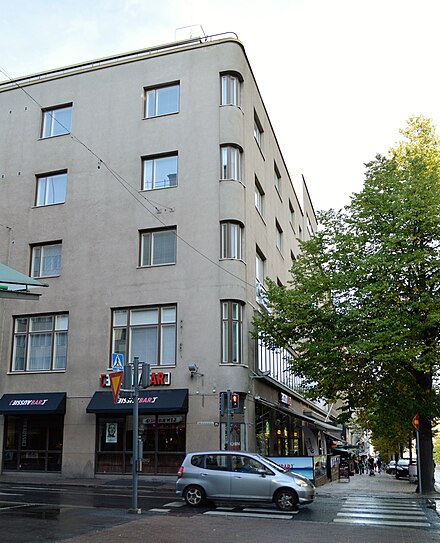
-
Hatanpää hospital (Hatanpään sairaala), Hatanpäänkatu 24. The hospital in the Hatanpää district comprises two buildings, the newer of them was designed by Bertel Strömmer and finished in 1935. The building has been expanded several times and nowadays also has a big glass corner that rather represents 21st century architecture. 2019-11-11
-
Hatanpää high school (Hatanpään lukio), Haapakuja 5, 61.4755°, 23.7611°. Hatanpää high school is based in the district of Rantaperkiö, in a building by Strömmer. 2019-11-11
-
Tullintori, 61.4972°, 23.7771°. Shopping mall in central Tampere that got its current form in 1990, but the core part is a functionalist building from 1930, built for the SOK cooperative. 2019-11-11
-
Nekala school (Nekalan koulu), Kuokkamaantie 16, 61.4833°, 23.7907°. Elementary school in a yellow functionalist building, finished in 1931. 2019-11-11
-
Buildings along Hämeenkatu. Hämeenkatu, the main street, is lined by several functionalist buildings. Starting from the east, right opposite the railway station is Hotel Emmaus, now operated by Scandic Hotels. The building was designed by Bertel Strömmer and Heikki Tiitola and finished in 1936. At Hämeenkatu 10 there's the building of the Voima cooperative by Georg Jägerroos. Across the Tammerkoski rapids, at Hämeenkatu 15 is the Tempo house finished in 1939 by Strömmer for the Tempo department store. Then at Hämeenkatu 26 there's the Tuotannon talo (lit. "House of Production"), as the office of the Tuotanto cooperative. This building from 1914 was damaged in a World War II bomb raid and remodelled as a functionalist building by, you guessed it, Bertel Strömmer, in 1941. 2019-11-11
Satakunta
- Lamellikasarmi. Niinisalo garrison features some military functionalism. One of the barracks (Lamellikasarmi) from 1935 designed by Kalle Lehtovuori and the hospital from 1937 are built in functionalist style. As this is a military area, the buildings can't be visited just like that. Garrisons in Finland training conscripts do have open days twice a year (usually in February and August), other times of the year you might be able to catch a glimpse of the Lamellikasarmi from the northern gate, and you could try to contact the army if they would allow you in. 2019-11-11

- Nakkila church (Nakkilan kirkko), Kirkkokatu 4 (Nakkila). Designed by Erkki Huttunen and finished in 1937, the church in Nakkila was the first functionalist church building in the country. As such, when finished it was radically different from other churches, which created some controversy. 2019-11-11
- Terassitalo, Alvar Aallon tie 4 (Kauttua village, Eura). This 1938 building by Alvar Aalto was an apartment building for the management of the A.Ahlström paper factory and ironworks in Kauttua. Around the same time, Aalto also designed Villa Mairea in Noormarkku (part of Pori) for Harry Gullichsen, the CEO of the A.Ahlström conglomerate and his wife Maire, but that building incorporated several different styles from functionalism to traditional Japanese architecture. 2019-11-11
- Pori railway station (Porin rautatieasema), Asema-aukio 3. Finished in 1937 after a design by Thure Hellström, this is one of a few functionalist railway stations in the country. It's a yellow two-story building with offices on the second floor. The benches in the waiting hall are still the original ones, and similar in design to the benches in Kuopio railway station (also a functionalist station). 2019-11-11
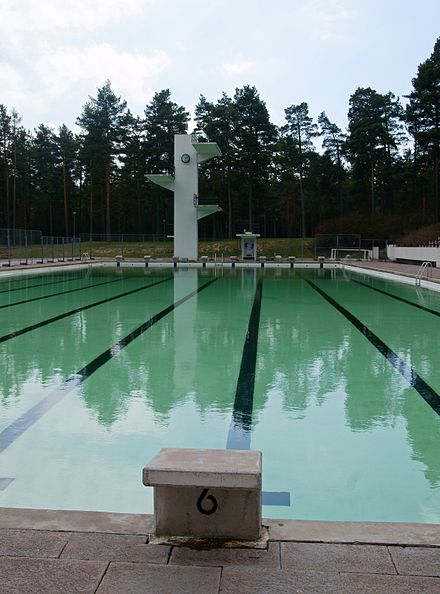
- Open air pool in Pori (Porin maauimala), Metsämiehenkatu 8. Pitched in the National City Park of Pori (Porin kansallinen kaupunkipuisto), this is together with Helsinki's swimming stadium, it's one of the best examples of functionalism meeting outdoor swimming. The pool was opened in 1957 after a design by Yrjö Lindegren. There's a big pool and two childen's pools, seating for 500 spectactors, and the place is open not just in the summer – but also in the winter for ice swimming! 2019-11-11
- Pori old shortwave station (Porin lyhytaaltoasema), 61.4647°, 21.8571°. The former shortwave radio station was built after a design by Hugo Harmia in Väinölä district to broadcast the 1940 Olympics around Europe and further away, but the war postponed the Olympics and the station's first use was sending wartime propaganda by Valtion tiedotuslaitos (lit. Governmental Information Bureau) in multiple languages. After the war it served as the main international broadcasting station for Finnish radio, providing Finnish-language content to for instance expatriates and seamen all over the world, as far as Australia. In 1987, operations were moved to new facilities in Preiviik west of the city. The old building is used by a car club and as a cultural center, and the building has reportedly not been well taken care off. 2019-11-11
- Hotel Raumanlinna, Valtakatu 5 (Rauma). A hotel and restaurant finished in 1933 by Erkki Huttunen, now operated by the Best Western chain. It also has a big nightclub which is the city's prime concert venue. At the time of completion, it also served as the Rauma headquartets of the right-wing Suojeluskunta militia organization, which was disbanded after World War II. 2019-11-11
- Hotel Vanha Rauma, Vanhankirkonkatu 26, 61.12750°, 21.51590°. Another functionalist hotel building in Rauma, next to Kalatori (the fish square) in Vanha Rauma (Old Rauma). It was designed as a store by the SOK's construction department and finished in 1937. Since the 1980s it's been a hotel, operating under different names. 2019-11-11
Kanta-Häme and Päijät-Häme
- Riihimäki railway station (Riihimäen rautatieasema). Like many important railway stations, the one in Riihimäki was expanded multiple times to deal with the growing number of passengers in the early 20th century, until a new bigger one was built in 1935 after a design by Thure Hellström, the main station architect of the national rail company at the time. This station building is still in use. 2019-11-11
- Vesilinna, Salpausseläntie 14 (Riihimäki). The "water castle" of Riihimäki was finished in 1952, and was the last of Erik Bryggman's buildings to be finished during his lifetime. As the name reveals it's a water tower, though the water tank takes up just a fifth of the building's volume – the rest is office space, and the building has also housed adult education classrooms. On the top of the 30 m high building there's a café and an observation deck with views to Hyvinkää in good weather conditions. 2019-11-11
- Hotel Aulanko, Aulangontie 93 (Hämeenlinna). In the 1930s the Aulanko Hill and surroundings just north of Hämeenlinna was developed into a tourist attraction and a place for going out, with a modern hotel and restaurant as its centerpiece. The building was finished in 1938 and designed by Märta Blomstedt and Matti Lampén. The opening of the hotel was a grand event attended by the Finnish "Who's Who" of the day, and the hotel is still in business today (and has been expanded over the years). 2019-11-11
- Finnish sports academy (Suomen urheiluopisto), Urheiluopistontie 400 (Vierumäki, Heinola). Finnish athletes of all sports — summer and winter, team and individual, professionals and amateurs come here to practice and compete. The main building is designed by Erik Bryggman, and the academy moved there in 1937 when it was finished after being based for a few years in Pälkäne and Kiviniemi (current Losevo in Russia). Vierumäki features facilities for a range of sports from ski jumping to golf. 2019-11-11
- Lahti old bus station (Lahden vanha linja-autoasema), Jalkarannantie 1, 60.9845°, 25.6504°. Lahti's old bus station was finished in 1939 according to a design by Kaarlo Könönen. Nowadays intercity buses stop at the new transport interchange next to the railway station, whereas the old station hosts a grocery store and a restaurant. 2019-11-11
- Hämeenlinna bus station (Hämeenlinnan linja-autoasema), Eteläkatu 1, 60.9949°, 24.4670°. Hämeenlinna bus station was designed by Olavi Sahlberg and finished in 1958, and is still where passengers get on and off buses in the city. Nevertheless, in 2017 the city presented plans to have a new bus station built and turn the old building into a market hall. 2019-11-11
- Forssa bus station (Forssan linja-autoasema), Vapaudenkatu 4, 60.8161°, 23.6304°. Another comparatively new functionalist building, also finished in 1958, by Yrjö Mykkänen, and is still used as a bus station. It went through a major renovation in 2014, so it's likely that it will still be used as a bus station for years to come. 2019-11-11
- Forssa theater (Forssan teatteri), Torikatu 8. Designed by Toivo Paatela and finished in 1939, first as a local headquarters for the militia organization Suojeluskunta (disbanded after WWII). The city theater has functioned in the building since it was founded in 1980. 2019-11-11
Finnish Lakeland

-
Kannonkoski church (Kannonkosken kirkko), Kirkkotie 13 (Kannonkoski). Designed by Pauli E. Blomstedt, who however didn't live to see it finished in 1938 — his wife Märta and brother Aulis, both architects, finished the design. During its construction a model of it was presented on the 1937 World Fair in Paris. The church is said to remind of an ocean liner sailing in the middle of a rural landscape. 2019-11-11
-
Muurame church (Muuramen kirkko), Sanantie 7 (Muurame). The first church to be completed after a design by Alvar Aalto, representing a transition in style from classicism to functionalism. It was finished in 1929, and also features some elements from Italian church architecture that Aalto picked up during a trip to Italy. 2019-11-11
-
Suolahti church (Suolahden kirkko), Katvelankatu 1 (Suolahti). This church, described as representing late functionalism was finished in 1940 and designed by Georg Henriksson. 2019-11-11
-
Varkaus Central Church (Varkauden pääkirkko), Savontie 3. The yellow central church of Varkaus was built in 1939 and designed by Martti Paalanen. The church is most notable for its altar fresco, which is the biggest in the Nordic Countries. 2019-11-11
-
Kuopio railway station (Kuopion rautatieasema), Asemakatu 1. Like the functionalist stations in Pori and Riihimäki, this too was designed by Thure Hellström together with Jarl Ungern and finished in 1934. 2019-11-11
-
Eino Pitkänen who designed many functionalist buildings in Kajaani, also designed some apartment buildings in Kuopio.
-
Wanha Jokela, Torikatu 26 (Joensuu), 62.6026°, 29.7652°. The "Old Jokela" building opened in 1939, and featured the Hotel and Restaurant Jokela, and the Kino Karjala movie theater. It was designed by Aulis E. Hämäläinen, an architect who created many functionalist buildings that got destroyed during WWII. The restaurant that closed in 2012 was the last business to operate in the building, it has since been empty. 2019-11-11
-
North Karelia Central Hospital (Pohjois-Karjalan keskussairaala), Tikkamäentie 16 (Joensuu). A 12-floor building by Jussi Paatela finished in 1953, this was the first "central hospital" (provincial hospital) in Finland. The 45 meter high building is on top of a ridge and as such visible from far away. 2019-11-18
-
Naissaari. Naissaari, an island in the Vaajakoski district of Jyväskylä has a two functionalist buildings by the cooperative SOK's architect Paavo Riihimäki, finished in 1934. They were built as a club house for the management, and as a residence for the CEO of SOK's candy factory (since the 1960s known under the Panda brand). 2019-11-11
-
Rautpohja district. A subdistrict of Mäki-Mattila, where in the years 1938–1940 a total of 14 functionalist apartment buildings for employees, as well as residences for the management of the State Artillery Factory (Valtion tykkitehdas) were built here. 2019-11-11
In addition, the districts of Wessmanninmäki, Hupeli and Tourula of Jyväskylä have some notable functionalist residential buildings.
Northern Finland
- Kajaani downtown. Eino Pitkänen is credited with largely designing modern Kajaani, with many buildings in functionalist style. His main job was designing buildings for Kajaani Wood Goods Joint Stock Company (Kajaanin Puutavara Osakeyhtiö). In the 1930s there weren't so many architects up there, so he also got to design public and commercial buildings including the central school (Kajaanin keskuskoulu) and many buildings along the main street Kauppakatu. 2019-11-11
- Koskikara, Brahenkatu 5 (Kajaani). Designed by Pitkänen as the home of the CEO of the Kajaani company and finished in 1941, this three-floor building is one of the most notable in central Kajaani. The company was a major player in the forest and paper industry back in the day, and several prominent guests dined here with the CEO, including president Kekkonen and the Soviet general secretary Brezhnev. From 1998 to 2019, a restaurant operated in the building, but as of late 2019 there are plans to turn it into an apartment building. 2019-11-11
- The Kajaani company also built and operated some hydroelectric power plants built in the region, they too were designed by Pitkänen. The Katerma (Kuhmo) and Koivukoski (central Kajaani) plants are good examples of functionalist plants.
- Further northwest Aarne Ervi designed several hydroelectric power plants in the Oulu River, together with adjacent housing areas; Monta, Pälli and Pyhäkoski plants in Muhos and Jylhä and Nuohua plants in Vaala.
- Lumijoki town hall (Kunnantalo (Lumilinna)), Kunnankuja 1. Quite an unusual functionalist building in many ways, built in wood, located in a small town and serving as a town hall. It was finished in 1938 and first used as the local headquarters for Suojeluskunta, and nowadays the town hall. 2019-11-11
- Oulu central school (Oulun keskuskansakoulu), Saaristonkatu 22. Former school, finished in 1934 after a design by Kaarlo Borg. Like many public buildings, it served as a military hospital during WWII. It continued to be used as a school until the 1970s, then as a health center until 2015. Now the building is disused and the city plans to sell it. 2019-11-11
- Weckman house (Weckmanin talo), Kirkkokatu 26 (Oulu). It was built as a residence for a business tycoon in 1902. It was remodelled by Eino Pitkänen in 1935-37 to its current functionalist look. It served as headquarters for the Oulu paper plant, and is nowadays a private school for Oulu's Swedish community. 2019-11-11
- Kontinkangas hospital (Kontinkankaan sairaala), Kajaanintie 46 (Oulu). The first part of Kontinkangas hospital was finished in 1937 and designed by Uno Ullberg, and the hospital was completed during WWII. Having served as Oulu's main hospital for decades, it's nowadays a rehab center and geriatric hospital, part of a cluster of hospitals in the Kontinkangas district. 2019-11-11
- Päivärinne sanatorium (Päivärinteen parantola), 64.8816°, 25.8621°. Built as a tuberculosis sanatorium in 1930-32 after a design by the architect brothers Jussi and Toivo Paatela, as tuberculosis became less prevalent, it has served as different types of hospital over the years. Since 2001 the building has been a rehab center for drug users and psychiatric patients. 2019-11-11
- Länsi-Pohja central hospital (Länsi-Pohjan keskussairaala), Kauppakatu 25 (Kemi). Another hospital in Northern Finland, built in the 1930s in line with the style of the time – functionalism. The building was finished in 1940 according to a design by Uno Ullberg, and expanded with new wings in 1971 and 1987 in the same style. It's still the central hospital for Kemi. 2019-11-11
- Chapel at Peurasaari graveyard (Peurasaaren hautausmaan kappeli), 65.7273°, 24.5828°. The cemetery was established in 1897, the chapel by Matti Pitkänen just before Christmas 1937. For being a functionalist building it does have some additional ornaments, most notably the pattern on the walls just below the roof. 2019-11-11
- Hotel Pohjanhovi, Pohjanpuistikko 2 (Rovaniemi). The first version of the hotel was designed by Märta and Pauli Blomstedt and opened in 1936. It was a state-of-the-art hotel with, for example, the first elevator and electrified kitchen in Finnish Lapland, warm water in all rooms and two restaurants. The Germans blew it up at the end of WWII, but a new hotel was built already in 1947, designed by Aulis E. Hämäläinen. The grand old hotel of Rovaniemi, many prominent guests have stayed here over the years. Today it's operated by Scandic Hotel. 2019-11-11
- Sevettijärvi Orthodox church, Sevettijärventie 9065 (Sevettijärvi). Designed by Ole Albert Gottleben and finished in 1951, this simple wooden church was first a prayer room (chasovnya), and after a renovation in 1992 it was designated a church. 2019-11-11
See also
- Le Corbusier World Heritage – the Swiss-French architect Le Corbusier was one of the inspirators of the style functionalism. Some of his works around the world have been listed as world heritage sites by UNESCO.
- Stockholm quay palace tour and Swedish Grace tour for earlier Nordic architecture
- Functionalist buildings are also prevalent in the other Nordic countries, Denmark in particular. In Central Europe, the Czech Republic is a good place to spot functionalist buildings.

